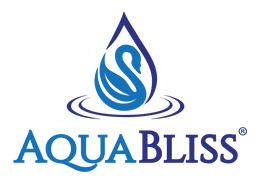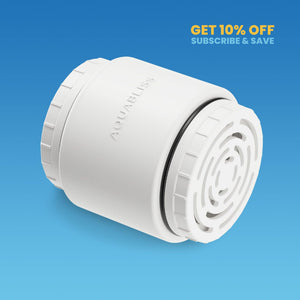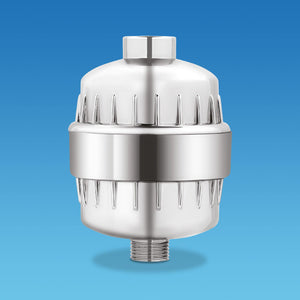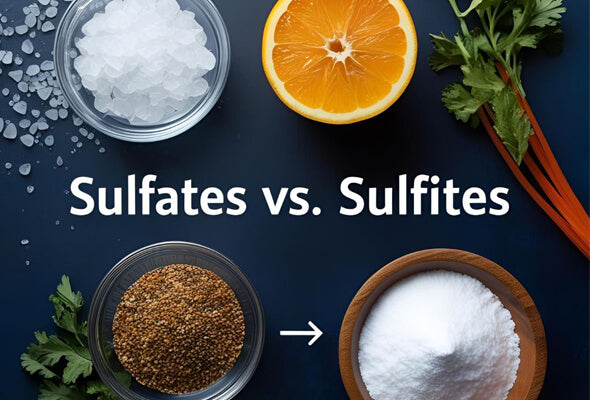Sulfates and sulfites are different sulfur-containing chemicals with vastly different applications. Sulfates are ionic compounds used in detergents, while sulfites, like sulfur dioxide, are used as food and drink preservatives.
Below, we explain the differences between sulfates and sulfites in more detail. While they might seem similar, they are quite different.
What are Sulfates?
Sulfates are “mineral salts” containing the SO42− anion, an ester of sulfuric acid. They have elemental sulfur and oxygen in the compound with an electric charge that shares electrons with another molecule to form a salt. Sulfates have useful chemical properties, so manufacturers use them in multiple products.
These include:
- Shampoos and body washes
- Toothpaste
- Soaps
- Handwashes
- Strong detergents
- Household cleaners
Sulfates are good for cleaning because of their ability to lather and remove grease and oil. Their anionic properties allow them to bond with fatty molecules, scooping them out of clothing, hair, and skin.
What are Sulfites?
Sulfites are compounds that contain the SO32− ion: they have one sulfur atom and three oxygen atoms (instead of the 4 oxygens in sulfates). This change might not seem significant, but it gives sulfites different chemical properties.
Their negative ion charge allows them to react with errant oxygen molecules, preserving nearby compounds. This property of sulfites is helpful for food preservation. Manufacturers often add the compound to items to prevent them from spoiling.
Sulfites are also useful in food and drug packaging because they can mop up errant oxygen molecules. Adding them can prevent damage to delicate, easily spoiled items.
Key Differences Between Sulfates and Sulfites
The differences between sulfates and sulfites are subtle yet critical.
Chemical Structure
As discussed, sulfates and sulfites have different chemical structures. The former has one sulfur atom bonded to four oxygen atoms, while the latter has one sulfur atom and three oxygen atoms. Interestingly, both have the same -2 charge, but this manifests in different ways.
Function and Usage
Sulfates and sulfites have different applications. Sulfates are found in cleaning products because they can pull grease and grime from surfaces, while sulfites are used for their antioxidant and preservative capacity.
Health Impact
Finally, the health impacts of sulfates and sulfites vary, though both compounds are pretty safe. Sulfates in personal care products can irritate the skin because their drying effects can lead to dermatitis, edema, or general dryness.
However, the effects of sulfites are different. They can put people with asthma at higher risk of attacks if they eat this compound in food or cause those with sulfite sensitivity to develop skin reactions and digestive issues.
How to Identify Sulfates and Sulfites in Products
Fortunately, you can identify sulfates and sulfites in products before you buy them.
Reading Labels

First, read the label. Most products will say in bold something like:
- Contains sulfates, or
- Contains sulfites
This labeling guarantees that the products are safe. If no such statement is present, check the ingredient list. Any chemical name with “sulfate” or “sulfite” contains these compounds.
Common Terms and Synonyms
Sometimes, sulfates and sulfites go by different names, including:
- Sodium laureth sulphate
- Calcium sulfate
- Magnesium sulfate
- Sodium lauryl sulfate
- Potassium sulfate
- Sodium sulfite
- Potassium bisulfite
- Sulfur/sulphur dioxide
- Potassium metabisulfite
- Sodium bisulfite
Watch out for these variations if you are sensitive to these compounds.
Product Categories
The range of product categories where sulfates or sulfites might be present is enormous. These chemicals are useful, so you can find them almost anywhere, which makes life trickier for people trying to avoid them. You will find sulfates in personal care products.
These items have the cleansing power to make consumers feel fresh and clean after buying them. You’ll find them in facial cleansers, conditioners, shampoos, and even body washes. Household cleaning products are another product category containing sulfates in high concentrations.
These compounds are usually the main ingredient in dishwashing and laundry detergents. However, you will also find them in all-purpose and carpet cleaners. Some cosmetics may contain smaller quantities of sulfates, including liquid foundations and lotions.
Manufacturers add these as stabilizers or emulsifiers to extend shelf life and improve the feel of products in the hands. Finally, the industry may use sulfates in some products. For instance, it is helpful as a cement additive to improve spreading and is a necessary part of agricultural fertilizer.
Sometimes, you also find it as calcium sulfate in drywall and plasterwork (something you will read on the tub label). Sulfites are also found in multiple products. We already mentioned food and beverages where manufacturers add them to dried fruits, wine, beer, some processed seafood, pickled foods, baked goods, jams, jellies, and Balsamic vinegar.
However, sulfites also make appearances in some injectable drugs (like epinephrine), inhalers, hair dyes, skin creams, and bleaches. The industry uses sulfites sometimes, too. For example, sodium bisulphite is a helpful water treatment chemical that removes chlorine.
Paper and pulp production may also use sulphites in bleaching processes. Finally, you may see sulfites used in sterilization applications in medical and laboratory settings. It can be a helpful alternative to harsher products.
Do AquaBliss Shower Filters Contain Sulfates or Sulfites?

AquaBliss shower filters contain sulfites for water filtration. These compounds reduce unwanted chemicals from hot and cold water, giving users a purer experience. Specifically, AquaBliss filters contain calcium sulfite, which is well-known for its chlorine-scrubbing abilities.
It can reduce the chlorine added by water boards, changing the way showers smell and feel. Water is less harsh and feels softer on the skin when the chlorine is removed. Furthermore, many people report hair health benefits. AquaBliss filters that remove chlorine reduce frizz and dryness, leaving hair feeling full and supple.
Please note, however, that AquaBliss shower filters do not contain sulfates. While these compounds are helpful in personal care products, they don’t serve any function in filters.
How to Reduce Exposure to Sulfates and Sulfites
Many individuals want to reduce exposure to sulfates and sulfites because of irritation or allergic reactions. But how can you do that?
Choose Sulfate-Free Personal Care Products
The easiest way to cut down is to choose sulfate-free personal care products. These include shampoos, body washes, conditioners, or anything else you put on your body that contains the compound.
Double-check the ingredient list to ensure the product is sulfate-free. It shouldn’t contain common detergents like sodium laureth sulfate or sodium lauryl sulfate. If concerned, only buy products that say “sulfate-free.” These use other surfactants, like coco-glucoside.
Switch To Natural Cleaning Products
Switching to natural cleaning products is another way to reduce sulfate exposure in your environment. Using sulfate-free detergents and cleansers cuts the risk of inhalation or the chemical coming into contact with your skin. For example, simple cleansers made of water, vinegar, and baking soda are always useful.
Check Your Cosmetics
At the same time, you should also check your cosmetics. Look for sulfates in makeup removers, creams, and facial cleansers–essentially anything you use to clean your face. Don’t use it if you can’t see an ingredient list on the product or the website. Alternatively, conduct a patch test to see if you react to it.
Limit The Use Of Epsom Salts
You can also reduce sulfate exposure by eliminating your use of Epsom salts. While these make for a relaxing bath, they contain high levels of magnesium sulfate.
Check Food And Beverage Labels
Always check the labels for sulfites, as many foods and beverages contain them. Manufacturers will often add sulfites as stabilizers and preservatives for long shelf life. Where possible, eat mostly fresh, whole foods like fruits and vegetables.
These natural products are far less likely to contain sulfites. Be particularly wary of high-sulfite foods and drinks, like dried fruit, molasses, Balsamic vinegar, and drinking wine. These products can create extreme reactions in sensitive people.
Ask About Restaurant Food
You should also ask restaurants whether their food contains sulfites. Most should have detailed lists of the additives that their meals contain in a ring binder. Ask the manager to come over and go through it with you if you have concerns.
Manage Your Sulfite Sensitivity
Sometimes, you can’t avoid sulfites entirely. Therefore, ensure you have a plan in place to deal with sensitivity. If you have asthma, keep your inhaler close by and keep a food diary to identify possible triggers.
Review Your Medications
Finally, review your medications. Pharmaceutical companies sometimes add sulfites to antibiotics or epinephrine injectors, and these may be causing unwanted reactions. Fortunately, many sulfite-free alternatives are available, including some over-the-counter medications.
So, What’s The Difference Between Sulfates and Sulfites?
Sulfates and sulfites are similar chemicals, but slight changes in their structure mean they have vastly different properties. Sulfates are primarily for cleaning, while sulfites are for preservation and filtering.
Sulfite-based filters in showers are helpful because they can scrub the chlorine content from water, eliminate odor, and provide numerous skin and hair health benefits. Order a high-performance shower filter from us today. Alternatively, contact our team.







